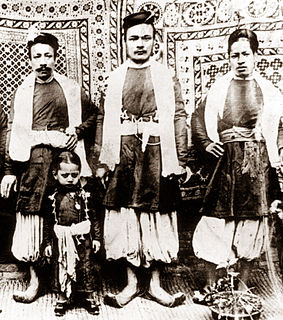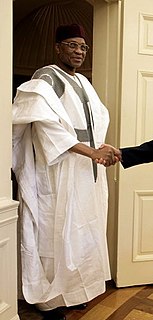A suit is a set of garments with matching pieces, typically a jacket and trousers.

A robe is a loose-fitting outer garment. Unlike garments described as capes or cloaks, robes usually have sleeves. The English word robe derives from Middle English robe ("garment"), borrowed from Old French robe, itself taken from the Frankish word *rouba, and is related to the word rob.
Wrapper generally refers to a type of packaging, such as a flat sheet made out of paper, cloth, cellophane or plastic to enclose an object.
Formal wear, formal attire or full dress is the traditional Western dress code category applicable for the most formal occasions, such as weddings, christenings, confirmations, funerals, Easter and Christmas traditions, in addition to certain state dinners, audiences, balls, and horse racing events. Formal wear is traditionally divided into formal day and evening wear; implying morning dress before 6 p.m., and white tie after 6 p.m. Generally permitted other alternatives, though, are the most formal versions of ceremonial dresses, full dress uniforms, religious clothing, national costumes, and most rarely frock coats. In addition, formal wear is often instructed to be worn with official full size orders and medals.

A chemise or shift is a classic smock, or a modern type of women's undergarment or dress. Historically, a chemise was a simple garment worn next to the skin to protect clothing from sweat and body oils, the precursor to the modern shirts commonly worn in Western nations.
Clothing terminology comprises the names of individual garments and classes of garments, as well as the specialized vocabularies of the trades that have designed, manufactured, marketed and sold clothing over hundreds of years.

A housecoat or morning gown is a robe, a loose-fitting outer garment, worn by either men or women. They are similar to a bathrobe but without the absorbent material.

A gown, from the Saxon word, gunna, is a usually loose outer garment from knee- to full-length worn by men and women in Europe from the Early Middle Ages to the 17th century, and continuing today in certain professions; later, gown was applied to any full-length woman's garment consisting of a bodice and attached skirt. A long, loosely fitted gown called a Banyan was worn by men in the 18th century as an informal coat.
Baptismal clothing is apparel worn by Christian proselytes during the ceremony of baptism. White clothes are generally worn because the person being baptized is "fresh like the driven manna".

A kirtle is a garment that was worn by men and women in the Middle Ages. It eventually became a one-piece garment worn by women from the late Middle Ages into the Baroque period. The kirtle was typically worn over a chemise or smock, which acted as a slip, and under the formal outer garment or gown/surcoat.
A garment is an article of clothing.

Scrubs are the sanitary clothing worn by surgeons, nurses, physicians and other workers involved in patient care in hospitals. Originally designed for use by surgeons and other operating room personnel, who would put them on when sterilizing themselves, or "scrubbing in", before surgery, they are now worn by many hospital personnel. Their use has been extended outside hospitals as well, to work environments where clothing may come into contact with infectious agents. Scrubs are designed to be simple, easy to launder, and cheap to replace if damaged or stained irreparably. In the United Kingdom, scrubs are sometimes known as theatre blues.

Hanfu is a term used for the historical styles of clothing worn by the Han people in China. The term "Hanfu" was coined by Chinese Internet users to broadly describe ancient Han Chinese people's clothing worn before the Qing dynasty. When people talk about Hanfu, they usually mean a long flowing robe with loose sleeves and a belt at the waist.. However, there are several representative styles of Hanfu, such as the ruqun, the aoqun, the beizi and the shenyi. Traditionally, the hanfu consisted of a robe or a shirt worn as the upper garment with a skirt commonly worn as the lower garment. Nowadays, hanfu is gaining recognition as the traditional clothing of the Han ethnic group and has experienced a growing fashion revival among young Han Chinese people in China and in the overseas Chinese diaspora.

Traditional Newar clothing refers to the everyday clothes worn by the Newar people of Nepal who are indigenous to the Kathmandu Valley and surrounding regions. The garments are associated with the old aristocracy, merchants, farmers, craftsmen and professionals.

Agbada is one of the names for a flowing wide-sleeved robe worn by men in much of West Africa, and to a lesser extent in North Africa, related to the dashiki suit.
Hospital gown may refer to:
The fashion industry in Nigeria plays an important cultural role and contributes significantly to the country's economics. Casual attire is commonly worn but formal and traditional styles are also worn depending on the occasion. Clothing incorporates a variety of colours, fabrics, and embellishments. Many of the component cultures of Nigeria wear styles that are unique to their tribal society and customs. Nigeria is known not only for its fashionable textiles and garments, but also for its fashion designers who have increasingly gained international recognition.








